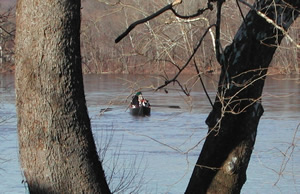
Soldiers, keep by your officers. For God’s sake, keep by your officers!” These orders sounded from General George Washington as he urged his men to take heed on the eve of the momentous victory at the Battle of Trenton in 1776. Lieutenant Elisha Bostwick, a soldier in Washington’s Continental Army, listened to Washington’s solemn encouragement that night and later recorded it into his journal, seemingly knowing that this moment in history should never be forgotten.
In the cold, harsh winter of 1776, the success of the American Revolution was doubtful; so much had gone wrong in the previous months. In August of 1776, 30,000 British troops, allies, and Hessian mercenaries arrived in the New York Harbor in order to seize control of the territory. In the campaign for New York that followed, Washington’s army was defeated time and time again. The Battle of Long Island was lost in August, with a thousand of Washington’s troops taken prisoner. In September, the British took New York City and occupied it for the rest of the war. In October, the British forced Washington’s troops to retreat farther north during the Battle of White Plains. Most disastrous, however, was the fight over Fort Washington in New York, when more than 2,000 men were taken prisoner. A few days later, the British captured Fort Lee in New Jersey, leaving the American troops discouraged by this avalanche of defeats.
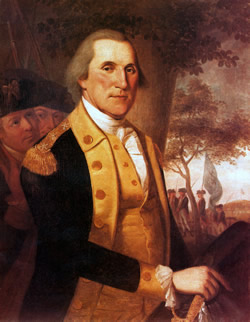
During the first week in December, Washington and his troops were forced to retreat to New Brunswick, New Jersey, and continue on towards Princeton, New Jersey. The British, however, were in close pursuit. Needing a quick escape, Washington ordered all boats within a 75 mile stretch of the river to be procured in preparation for the retreat into Pennsylvania. After crossing the river into Pennsylvania, the boats and a 25 mile stretch of the river were guarded so that the British could not follow.Washington feared that Philadelphia would soon be taken by the British if their advance was not halted. Because of this concern, by mid-December, the Continental Congress abandoned Philadelphia for Baltimore in fear of the British approach.
As the battles continued, Washington’s army diminished in size. In August, Washington had an army of 20,000, but by December he had only about 3,500 under his personal command. In a few months, on January 1, 1777, he would lose the rest of his soldiers when all enlistments would expire. At the moment, Washington’s army was demoralized and badly in need of clothing, shoes, and supplies. Many were sick and dying. Others were deserting. It was clear that a victory was desperately needed.
Washington originally conceived his daring plan to take Trenton, New Jersey as a three-pronged attack. His strategy included the combined efforts of two forces led by fellow American generals, General Charles Ewing and General John Cadwalader. These two groups were to cross further down the Delaware River and provide support. Across the river from Trenton and nine miles north, Washington and 2,400 troops began crossing the icy and treacherous Delaware River on Christmas night, 1776. The crossing was made in big, flat bottomed, high-sided Durham boats. The largest of these could carry as many as forty standing men. Although it took until 3 a.m. for all of Washington’s troops to cross, not a piece of equipment that was lost. Time, however, had been lost. The plan was three hours behind schedule, and the attack would not begin under the cover of darkness. The element of surprise on which the bold attack rested on was in jeopardy. Despite this, Washington made the decision to continue. He was unaware, however, that General Ewing’s and Cadwalader’s supporting forces were unable to cross the river due to the icy conditions.
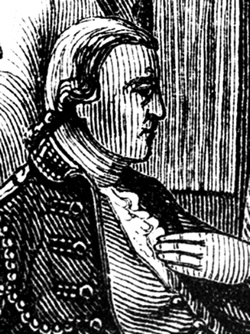
Upon successful maneuvering across the river, Washington and his men began the nine mile march to Hessian-held Trenton. Due to the severity of the weather, Hessian Colonel Johann Rall had called off the morning patrol. Washington caught the enemy off-guard, and he and his army defeated the Hessian forces at the Battle of Trenton. In a violent snowstorm, and in 45 minutes or less, 900 Hessians were taken prisoner, 21 were killed and 90 were wounded. Only five hundred Hessians were able to escape. In the words of David McCullough, a noted Revolutionary War historian, “It was Trenton that meant the most, Trenton and the night crossing of the Delaware that were rightly seen as a great turning point. With the victory at Trenton came the realization that the Americans had bested the enemy, bested the fearsome Hessians, the King’s detested hirelings, outsmarted them and outfought them, and so might well again.” The victory that Washington so desperately needed was finally obtained.
The outcome of that night was never forgotten. The significance of Washington and his men bravely crossing the treacherous river and defeating an enemy remains an integral part of United States history and an important image for the nation. The power this moment demonstrated has permeated American society. Because of this, Americans are constantly reminded of this important occasion through art, cinema, and even legal tender.
The account of the Crossing has inspired numerous artists to offer their own interpretation of this famous crossing of the Delaware River. Below is Emanuel Leutz’s famous painting, Washington Crossing the Delaware. Painted in 1851, the sheer size of the painting adds to its drama; it measures 12 feet by 21 feet. The original hangs in the Metropolitan Museum of Art in New York City.
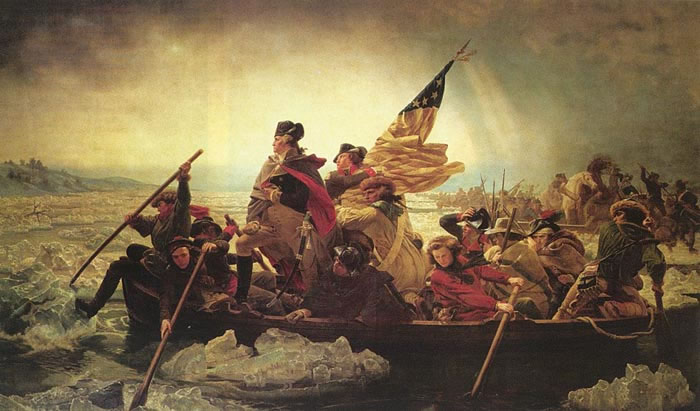
Although the painting is a well-known image of American history, its historical accuracy has been called into question. Much debate has ensued over whether Washington actually would have been standing in the boat during the crossing. Many contend that Washington would have been seated. Historians disagree, however, and point out that the Durham boats used to cross the river had no seats. All the troops and oarsmen would have been standing. Other inaccuracies in the painting include the fact that the flag depicted in it was not yet adopted and that the ice does not form in the Delaware River as it is represented. The lighting is also suspect as the crossing was made in the darkness of night and in the midst of a violent snowstorm.
David Hackett Fischer, in his book Washington’s Crossing, acknowledges the “debunkers” of Leutz’s work, but champions the “accuracy of its major themes.” He writes, “The artist was right in creating an atmosphere of high drama around the event, and a feeling of desperation among the soldiers in the boats....The artist captured very accurately their sense of urgency, in what was truly a pivotal moment for American history.” The symbolism portrayed as Washington stands against the dramatic background is clear. Washington, the General, stands tall, dignified, and focused on the future—the embodiment of the American spirit.
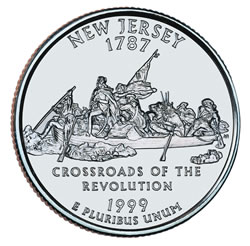
Leutz’s version of the Crossing has become a familiar image. In testimony to its popularity, it has been modified, manipulated, and parodied by various cartoonists and illustrators. Linus, from the Peanuts comic strip, sculpted the image in snow, and a Far Side calendar has Washington crossing the street instead of the river. In 1999, the U.S. Department of the treasury’s 50 State Quarters Program released the New Jersey State Quarter. On its face is the iconic image of Leutz’s scene, along with the title, “Crossroads of the Revolution.” Although people may not realize it, the memory of the event is with them even as they handle their loose change.
The works of other artists and illustrators have contributed to our cultural awareness of Washington’s crossing of the Delaware, as well. Contemporary artist Peter Fiore’s version, The Crossing, offers a different perspective of the events that night, showing the soldiers in their preparations to cross the dangerous river. In 2004, Lynne Cheney, wife of former Vice President Dick Cheney, featured Fiore’s work in her children’s book When Washington Crossed the Delaware. In addition, an A&E film titled The Crossing was released in the year 2000. Adapted from a best-selling novel by Howard Fast, the film stars Jeff Daniels as General Washington, and details the Continental Army’s retreat into Pennsylvania, the crossing of the Delaware, and the Battle of Trenton. The film won a Peabody Award for excellence in 2001.
The site itself, where Washington and his troops crossed the Delaware and brought new life and confidence to the Revolution, has become an honored and often visited site. In 1917, nearly 150 years after that decisive victory, the Washington Crossing Historic Park opened in Washington Crossing, Pennsylvania. Providing tours and presenting exhibits, the park seeks to broaden public understanding and preserve the historic site. With an exact copy of Leutz’s painting hanging in the visitor’s center, it is not hard for guests to feel a sense of pride and awe as they stand on those famous grounds.
The park includes McConkey’s Ferry Inn, which was the only existing structure on the immediate grounds of the park at the time of the crossing in 1776. The inn, owned at that time by Samuel McConkey, was a guard post during the Continental Army’s stay in Bucks County. Washington and his aides dined at the tavern prior to their crossing of the river on Christmas Day.
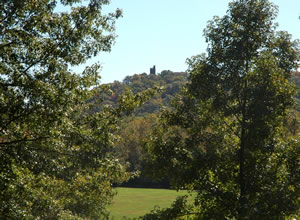
The Washington Crossing Historic Park has grown to include Bowman’s Tower and the Thompson-Neely House, as well. These structures are approximately five miles from the McConkey Ferry section of the park where Washington’s crossing of the Delaware actually took place. They provide a glimpse of what Washington and his men would have seen and visited during the Revolution.
Bowman’s Tower was constructed in 1931, as a monument commemorating General George Washington and his army. The Tower sits on a site that may have been a lookout point for Washington’s troops as they watched the banks of the Delaware River for enemy activity. The construction of the tower fulfilled the Washington Crossing Park Commissions’ objectives, which were broadened in 1929 beyond preserving the site as a national shrine to include the preservation of the site’s natural beauty and development of its areas for recreational use. The tower was erected using native stone from local quarries and was constructed entirely by employees of the Park’s Commission. It is 125 feet high and stands 380 feet above sea level. On a clear day, from the top of the tower, one can see to Trenton, New Jersey and the distance Washington and his troops traveled back in 1776. Also visible from the tower is an American flag marking the graves of soldiers who perished during the Revolutionary War.
The Thompson-Neely House, located along Pidcock Creek, was used during the winter of 1776-1777 to aid and care for wounded soldiers. It was once referred to as the “House of Decision,” as it was thought that it was here Washington planned the attack on Trenton. There is no research, however, to support this claim.
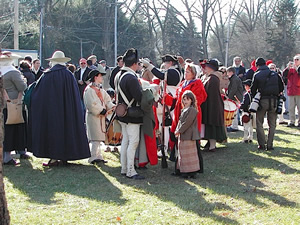
The history of Washington Crossing continues to be celebrated with the Annual Christmas Crossing Reenactment that takes place each year on Christmas Day. The first annual reenactment was conducted on December 25, 1952. Since then, at 1 pm every year, reenactors dressed in Continental military uniforms cross the Delaware in replicas of the Durham boats Washington used in 1776. Although the weather on the evening in 1776 was treacherous, today the re-enactors do not cross the river unless the conditions are deemed safe. Regardless of the weather, the General Washington impersonator addresses his troops, and speeches and ceremonies take place to commemorate the event. Open hearth cooking and other historical demonstrations are also staged in order to bring audience members even more into the spirit of the event.
Since its opening in 1917, thousands of tourists have visited the park each year to learn more about the site’s historical importance and the significance of the Crossing. Sadly, however, on November 22, 2009, the park had to temporarily shut down due to budget cuts. Because of community dedication and involvement, however, the Christmas Day reenactment still occurred. Currently, the state museum commission is considering taking over the staffing of the park. With hope, the park will open again soon; the significance of the park and the meaning behind it should never be forgotten. Thomas D. Fleming, noted author of Liberty! The American Revolution, reflects this belief: “Christmas 1776, the victory at Trenton is something that Americans should always remember as long as the country lasts, because it shows, I think, some deep toughness at the center of the American spirit, personified by Washington and his small band of men, so it’s a memory that we should never abandon.”
Sources:
- Davis, General W. W. H. “Washington on the West Bank of the Delaware, 1776.” The Pennsylvania Magazine of History and Biography 4.2 (1880): 133-64
- Fischer, David Hackett. Washington’s Crossing. Oxford: Oxford University Press, 2006.
- Fleming, Thomas. Liberty! The American Revolution. New York: Viking, 1997.
- “George Washington Crosses The Delaware River!” The Gentleman’s Magazine [London] March 1777.
- Hanauer, David. “Washington Crossing.” David’s Photographic Tour of Bucks County, Pennsylvania. 2004. <http://www.davidhanauer.com/buckscounty/washingtoncrossing/>.
- Menno, Christian. “Park Temporarily Shuts Down.” Intelligencer [Bucks County, PA] 22 Nov. 2009. <http://www.phillyburbs.com/news/local/the_intelligencer/the_intelligence....
- McCullough, David. 1776. New York: Simon & Schuster, 2005.
- Parker, David B., and Torrance Parker. A Chautauqua Boy In ‘61 and Afterward. Boston: Small, Maynard and Company Publishers, 1912.
- “Sunday Call Sketch Correcting Historical Slip in U.S. Archives.” The Sunday Call [Newark, NJ].
- Thistlethwaite, Mark. “Washington Crossing the Delaware: Navigating the Image(s) of the Hero.” George Washington In and As Culture. Ed. Kevin L. Cope. New York: AMS, 2001. 39-63.
- “Washington Crosses the Delaware, 1776.” EyeWitness to History, 2004 <http://www.eyewitnesstohistory.com/washingtondelaware.htm>.
- Washington Crossing Historic Park. Pennsylvania Historical and Museum Commission, n.d. <http://www.ushistory.org/washingtoncrossing/>.
